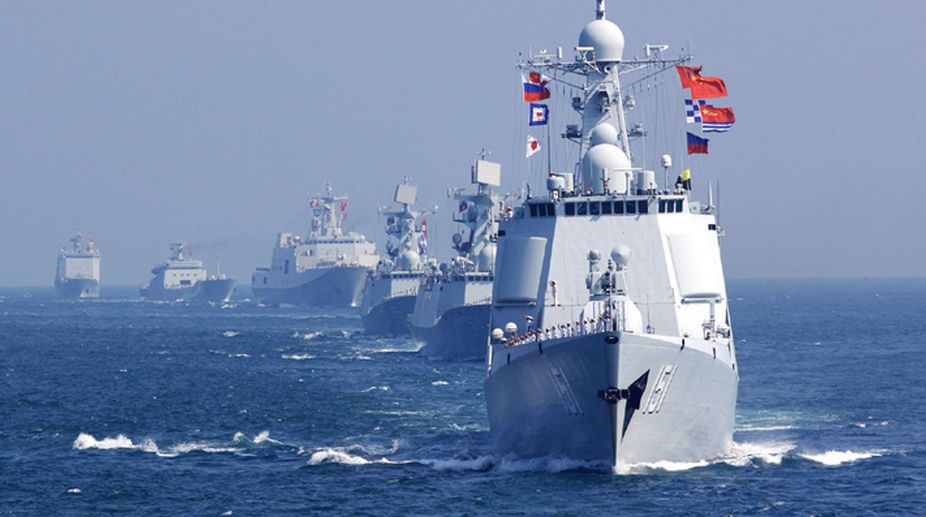The strategic location of the Andaman and Nicobar Islands may be used by India to develop an effective deterrent to China’s growing presence in the IOR. About 120,000 ships pass through the Indian Ocean every year and nearly 60 per cent of these pass through the Malacca Strait, China’s lifeline for importing its vital oil cargo from the Gulf. It is a vital chokepoint and also the gateway of China to the IOR, and India can monitor and control it from the ANI, and even block it using its aircraft carrier and other force multipliers, with some assistance from the allies in Quad, especially the USA.
The Malacca Strait is one reason why China has invested so much on the CPEC, in order to have access to sea through the deep-sea warm-water seaport of Gwadar in Pakistan. The current border clashes are an offshoot of this, as the CPEC runs very close to Depsang, Galwan and Daulat- Beg-Oldie Airbase at the LAC, through which the Indian Army can threaten the CPEC, just like the Malacca Strait can be choked by the Indian Navy. But Malacca is not the only chokepoint in the region – the Straits of Sunda and Lombok in Indonesia are also strategically important, because by choking these two along with Malacca, Chinese energy supply can be stopped altogether, leaving China with no option but to take a detour via the Bass Strait between Australia and Tasmania, and the Quad alliance may even choke that.

China is not unaware of these potential threats. Though India lags way behind China in reinforcing naval capability, it has not really been passive. It actively engaged with Indonesia which permitted India to invest in its Sabang Port located near the Strait of Malacca, provoking the Global Times to warn that if India indeed planned “to get military access to the strategic island of Sabang, it might get entangled in a conflict with China and will eventually regret its decision” and that “China would not turn a blind eye on India’s military collaboration with Indonesia.”
Indonesia is peeved at China for encroachment into the exclusive Indonesian maritime boundary close to the Natuna Island. India is also eying to sign a pact with Australia for using its Cocos (Keeling) Islands and build a naval base there and for reciprocal access to the ANI and Cocos Island to counter Chinese aggression. The Cocos (Keeling) Islands are strategically located near the Indonesian straits of Sunda, Lombok, and Ombai-Wetar, which together provide the entry and exit points between the Indian and the Pacific Oceans. India must also engage closely with Philippines, Brunei, Taiwan, Malaysia and Vietnam, all of which have been bullied by China in the South China Sea.
Among India’s allies, the US has a huge base at Diego Garcia and France still possesses the Indian Ocean islands of Reunion, Mayotte and Kerguelen, which can be leveraged to India’s advantage. To force China to scale down its military presence in the IOR will not be easy. It would need careful planning and capacity building by the Indian Navy for distant power projection, in collaboration with the allies, for a sustained presence in the Indo- Pacific Region (IPR) which China today considers as its very own maritime backyard, to recalibrate the maritime balance in Asia.
Though difficult, a sustained naval presence by India in the IPR may be the only way to counter Chinese intransigence in the IOR or even to contain Chinese intrusions along the LAC. For that we need to change our current strategy of reckoning the IPR only a secondary theatre of interest. IPR ~ a term China loathes, is of vital interest to China as it offers China the only direct access to the sea. The eastern coast is where China’s major industries, population and industrial centres are located, it is also the centre of China’s prosperity and strength as well as weakness, because it is here that China faces threats from the USA, Japan and other Asean countries it has antagonised ~ no wonder China is so sensitive about its absolute control over the East and South China Seas.
It also must be reckoned that any hostility with India on its western flank is bound to divert and lock up substantial military resources and assets away from its vulnerable eastern flank. It is here that India holds an advantage and must leverage it to shape the security dynamics in the Pacific in its own favour. The major elements of this strategy would be mutual logistics support agreements like the one signed with Australia last month and closer cooperation with the USA, Japan, Singapore, Vietnam and Indonesia and may be Philippines and Malaysia also, to demonstrate solidarity through joint naval exercises, like the one currently underway by the dual aircraft carriers USS Ronald Reagan and USS Nimitz in the South China Sea, for asserting the rights of nations to use the sea for navigation and other purposes.
It will be sure to provoke China, but to contain its aggressive designs in the IOR, India must change its policy of only being reactive to Chinese transgressions and start being proactive. Just like China’s String of Pearls in the IOR, India can have its own String of Pearls in the IPR. For this India must increase its maritime power and ability to intervene in the Indo-Pacific, which alone will increase its value as a partner in the Quad or to the Asean countries as a dependable ally, in which case it can exploit the common anti-Chinese sentiments among nations bullied by China.
As the US intelligence analyst Harry Hannah writes, China’s BRI is increasingly mirroring the policies of the European colonial powers. The perception of neo-colonialism is unlikely to get China many friends in the region, despite its growing military presence which could “end up being an expensive foray that yields minimal comparative advantage relative to India or the United States in the event of a war.” The former Malaysian Prime Minister Mahathir Mohamed emphatically said in 2018 in Beijing, “we do not want a situation where there is a new version of colonialism happening because poor countries are unable to compete with rich countries.” Indeed, IOR and Indo-Pacific may well decide the geopolitics of the twenty-first century.
“China and the United States have entered a state of comprehensive struggle, amounting to full-spectrum rivalry”, Rory Medcalf wrote in his Contest for the Indo-Pacific: Why China Won’t Map the Future. But the USA is not as powerful a global player as it used to be and the geopolitical order in which its Southeast Asian allies ~ Australia, Japan, South Korea, Singapore, the Philippines and Thailand ~ used to depend on the security blanket provided by USA ~ is in disarray. The US withdrawal from trade and economic partnerships like the Trans-Pacific Partnership, its ongoing trade war with China, and the withdrawal of security blanket from East Asian countries ~ all these have created a void which China has quickly filled up to make inroads into these countries and bully them into accepting its BRI.
Without trade or economic ties, the US Indo-Pacific Strategy is getting anchored only to military cooperation and military concerns, which also must change. An unpredictable and confrontational Trump has made things worse by isolating Iran, thereby weakening Iran-India ties and giving China the opportunity to capitalise by expanding its ties with Iran.The void left in the framework of American alliances can be filled by India with its economic and military heft to resuscitate a new military and economic alliances, with Vietnam and Indonesia included in the Quad and maybe other powers too which are interested in a rulebased order in a multipolar world.
The US, Australia and Japan can certainly help India reduce the power asymmetry with China in terms of military capacities. A defence pact could be in the future agenda. We should have no doubts that border incursions are less about territorial expansion and more about asserting Chinese hegemony which may need a reappraisal and resetting of the Indian strategy.In September 2019, speaking at the Indian Ocean Conference in Maldives, our Foreign Minister had articulated, “The Indo-Pacific is as much our past as it is our future.
Whether it is strategically viable depends on the politics of the day as it did before.” He asserted that the future of Indo-Pacific would be defied by “the ambitions of the China, the interest of India, the re-emergence of a Japan, the confidence of an Australia and the awareness of an Asean amongst others. Like politics, strategic concepts respond to times and the moment of Indo-Pacific could have arrived.” Maybe, the current extensive drill being conducted by the Indian Navy off the ANI is signalling a changed intent and a strategic shift away from the usual defensive posture hitherto adopted by India.
(Concluded)
(The writer is a commentator. The views expressed are personal)











